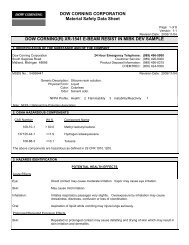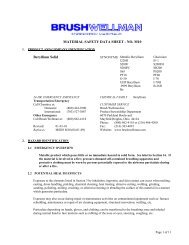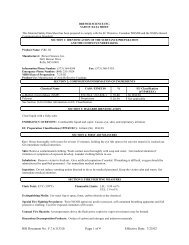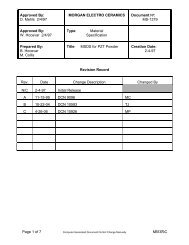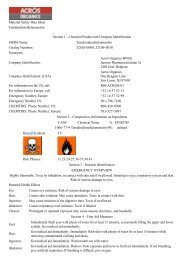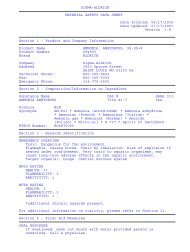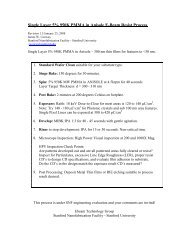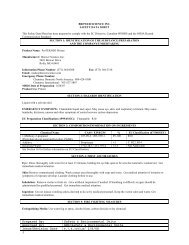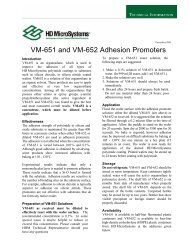Contact Mask Design Principles - Stanford Nanofabrication Facility
Contact Mask Design Principles - Stanford Nanofabrication Facility
Contact Mask Design Principles - Stanford Nanofabrication Facility
You also want an ePaper? Increase the reach of your titles
YUMPU automatically turns print PDFs into web optimized ePapers that Google loves.
© 2004, A.M. Fitzgerald & Associates<br />
<strong>Contact</strong> <strong>Mask</strong> <strong>Design</strong> <strong>Principles</strong><br />
Alissa M. Fitzgerald, Ph.D.<br />
Principal, A.M. Fitzgerald & Associates<br />
<strong>Stanford</strong> <strong>Nanofabrication</strong> <strong>Facility</strong> Open House<br />
April 21, 2004<br />
A. M. Fitzgerald & Associates<br />
655 Skyway Rd., Suite 118, San Carlos, CA 94070<br />
www.amfitzgerald.com
Tutorial Outline<br />
• Simple strategies for getting your masks right the first time, avoiding<br />
process headaches, and design for SNF-specific tools.<br />
– Understanding contact aligners and tool-specific issues<br />
– How process impacts mask design<br />
– Alignment marks and strategies<br />
– <strong>Mask</strong> layout tips and tricks<br />
– <strong>Design</strong> rules: the basics<br />
– Avoiding data file disasters<br />
© 2004, A.M. Fitzgerald & Associates<br />
A. M. Fitzgerald & Associates<br />
655 Skyway Rd., Suite 118, San Carlos, CA 94070<br />
www.amfitzgerald.com
SNF Exposure Tools<br />
© 2004, A.M. Fitzgerald & Associates<br />
Name Ultratech 1000 Karl Suss EV 620 Nikon NSR<br />
Type 1:1 Stepper <strong>Contact</strong> <strong>Contact</strong>/Prox 5:1 Stepper<br />
<strong>Mask</strong> Size 3X5" 4" and 5" 5" 5"<br />
Wafer Size 4" * pieces-4"** 4" 4"<br />
Maximum<br />
Exposure Area<br />
sq. = 10 x 10 mm.<br />
rect = 21 x 7.2 mm<br />
5" mask = 4"<br />
4" mask = 3"<br />
A. M. Fitzgerald & Associates<br />
655 Skyway Rd., Suite 118, San Carlos, CA 94070<br />
www.amfitzgerald.com<br />
4" diameter 4"array<br />
Obj. Separation 10- 21mm*** 50-100mm 65mm<br />
~ mininum resolution 1.25um lens rated**** 1um 1um .6um<br />
Additional Features Site-by-site stepper Backside align Anodic Bond,backside align 5:1 reduct.<br />
Exposure Information<br />
•6 inch manual loader is also available.<br />
** 4 inch diameter is the maximum<br />
*** Aperture separation<br />
**** Down to 0.8um can be achieved in isolated circumstances.<br />
EV620 Objective range<br />
•Top side objective travel range: x direction 30 - 150mm separation (8 - 150mm optional); y direction +-75mm; z direction +-5mm<br />
•Bottom side objective travel range: x direction 30 - 100mm separation (8-100mm optional); y direction +-12mm, z direction +-5mm
<strong>Contact</strong> aligners and tool-specific issues<br />
• Max linewidth resolution<br />
– Don’t design linewidths narrower than aligner<br />
capability!<br />
• Max x-y tolerances<br />
– Best case layer-to-layer alignment tolerance (20X<br />
objectives, vacuum contact, skill)<br />
© 2004, A.M. Fitzgerald & Associates<br />
• ~ 0.6 um for top side<br />
• ~ 1 um front-to-back<br />
– Your designs should accommodate expected<br />
alignment error – based on your skill level and<br />
process (2 um is a safe number)<br />
4 um<br />
2 um<br />
x + 2 um<br />
misalignment<br />
A. M. Fitzgerald & Associates<br />
655 Skyway Rd., Suite 118, San Carlos, CA 94070<br />
www.amfitzgerald.com<br />
x + 2 um, y + 2 um<br />
misalignment<br />
Karl Suss MA-6<br />
resolution
<strong>Contact</strong> aligners and tool-specific issues<br />
• Location of objectives<br />
– Range of motion is limited, so<br />
alignment marks must be in<br />
specific locations on mask<br />
EV620 Objective range<br />
• Top side objective travel range: x direction 30 - 150mm<br />
separation (8 - 150mm optional); y direction +-75mm; z<br />
direction +-5mm<br />
• Bottom side objective travel range: x direction 30 - 100mm<br />
separation (8-100mm optional); y direction +-12mm, z<br />
direction +-5mm<br />
• Objective field of view size<br />
– Determines how large to<br />
make alignment marks<br />
• Unique tool features<br />
– Karl Suss vacuum lines, e.g. Karl Suss Chuck Vacuum lines<br />
© 2004, A.M. Fitzgerald & Associates<br />
A. M. Fitzgerald & Associates<br />
655 Skyway Rd., Suite 118, San Carlos, CA 94070<br />
www.amfitzgerald.com<br />
drawing by Matt Hopcroft
<strong>Mask</strong> writer features<br />
• The fracturing grid: 0.5um for contact<br />
masks made at SNF<br />
– <strong>Mask</strong> writer takes in GDSII data,<br />
and ‘fractures’ or pixelates it<br />
– Fracturing grid determines ultimate<br />
resolution of the mask<br />
– Contract vendors can do 0.10 um,<br />
0.25 um, but you pay dearly for<br />
resolution<br />
• <strong>Mask</strong>writer is designed to best handle<br />
‘Manhattan geometry’<br />
– Squares, rectangles, 90 degree<br />
corners<br />
© 2004, A.M. Fitzgerald & Associates<br />
A. M. Fitzgerald & Associates<br />
655 Skyway Rd., Suite 118, San Carlos, CA 94070<br />
www.amfitzgerald.com<br />
The Grid
<strong>Mask</strong> writer features<br />
• Polygons can be problematic<br />
– Circles, polygons, and slanted lines<br />
burden the conversion process<br />
because they are ‘off-grid’<br />
– Large numbers of polygons will<br />
dramatically increase conversion time<br />
• At SNF, you may exceed mask<br />
writer capability<br />
• At commercial vendor, this will<br />
increase your mask cost<br />
• Avoid polygons unless you really need<br />
them<br />
© 2004, A.M. Fitzgerald & Associates<br />
A. M. Fitzgerald & Associates<br />
655 Skyway Rd., Suite 118, San Carlos, CA 94070<br />
www.amfitzgerald.com
© 2004, A.M. Fitzgerald & Associates<br />
How process affects mask design<br />
A. M. Fitzgerald & Associates<br />
655 Skyway Rd., Suite 118, San Carlos, CA 94070<br />
www.amfitzgerald.com
Know your process before you start your mask<br />
• <strong>Design</strong> your mask to fit your process and vice versa<br />
– Alignment to crystal axis (piezoresistors, anisotropic Si etch)<br />
– Lithography<br />
© 2004, A.M. Fitzgerald & Associates<br />
• Edge bead removal<br />
• Critical dimensions<br />
– Wet etch<br />
• Undercut compensation<br />
– DRIE etch<br />
• Center to edge variations in etch rate<br />
• Undercut compensation<br />
A. M. Fitzgerald & Associates<br />
655 Skyway Rd., Suite 118, San Carlos, CA 94070<br />
www.amfitzgerald.com
Alignment to crystal axis: crude alignment<br />
• Some processes require alignment to<br />
crystal axis<br />
– Piezoresistors<br />
– TMAH/KOH etching<br />
• For crude alignment to wafer flat:<br />
– Need alignment features in flat<br />
area of mask<br />
– Wafer flat is only within 2 degrees<br />
of true crystal axis<br />
© 2004, A.M. Fitzgerald & Associates<br />
<strong>Mask</strong> features<br />
near wafer flat<br />
A. M. Fitzgerald & Associates<br />
655 Skyway Rd., Suite 118, San Carlos, CA 94070<br />
www.amfitzgerald.com
Alignment to crystal axis: precise alignment<br />
• For precise alignment:<br />
– Need mask with an etch<br />
pattern<br />
– First process step: etch wafers<br />
in KOH/TMAH to reveal <br />
direction<br />
– Subsequent mask layers must<br />
have alignment marks that<br />
register with etch pattern<br />
© 2004, A.M. Fitzgerald & Associates<br />
<strong>Mask</strong> features<br />
near wafer flat for<br />
crude align<br />
A. M. Fitzgerald & Associates<br />
655 Skyway Rd., Suite 118, San Carlos, CA 94070<br />
www.amfitzgerald.com<br />
Crystal plane<br />
indicator pattern
Lithography considerations<br />
• Edge bead removal (EBR) will<br />
remove outer 2 – 5 mm edge of<br />
resist<br />
– Any mask features in this<br />
area will be lost<br />
– Don’t put alignment marks in<br />
this zone<br />
• Don’t pattern to edges of wafers<br />
– Tool holders<br />
– Etch non-uniformity<br />
– Device yield usually poor<br />
© 2004, A.M. Fitzgerald & Associates<br />
EBR removes 2-5 mm<br />
A. M. Fitzgerald & Associates<br />
655 Skyway Rd., Suite 118, San Carlos, CA 94070<br />
www.amfitzgerald.com<br />
Resist<br />
Don’t put mask features<br />
here!
Lithography considerations<br />
• Disparate feature sizes will drive you<br />
crazy during processing<br />
• For a given expose and develop<br />
time, or etch process:<br />
– By the time large features are<br />
developed, small features may<br />
be over-developed<br />
• Options:<br />
– Split your designs into two<br />
separate mask sets<br />
– Compensate smaller features<br />
© 2004, A.M. Fitzgerald & Associates<br />
A. M. Fitzgerald & Associates<br />
655 Skyway Rd., Suite 118, San Carlos, CA 94070<br />
www.amfitzgerald.com<br />
<strong>Mask</strong><br />
Reality
Wet etch considerations<br />
• Undercut compensation needed<br />
for isotropic etch processes<br />
– Lateral loss is equal to etch<br />
depth<br />
– Compensate mask data to<br />
make sure you get what you<br />
want on the wafer<br />
– Some mask writers can<br />
automatically add “bias” –<br />
positive or negative<br />
© 2004, A.M. Fitzgerald & Associates<br />
Resist<br />
1 um<br />
1 um<br />
Lateral undercut = etch depth<br />
A. M. Fitzgerald & Associates<br />
655 Skyway Rd., Suite 118, San Carlos, CA 94070<br />
www.amfitzgerald.com<br />
<strong>Mask</strong> Undercut feature<br />
Biased<br />
mask<br />
Desired result
DRIE etch considerations<br />
• Non-uniform etch rates<br />
– Wafer location<br />
– Feature size<br />
– Loading (open area/wafer area)<br />
• Use it to your advantage!<br />
– Small features on wafer perimeter<br />
– Large features in wafer center<br />
Pattern area affects etch rate<br />
© 2004, A.M. Fitzgerald & Associates<br />
Silicon<br />
Resist<br />
A. M. Fitzgerald & Associates<br />
655 Skyway Rd., Suite 118, San Carlos, CA 94070<br />
www.amfitzgerald.com<br />
Fastest etch rates<br />
Slowest<br />
etch rates<br />
Wafer location<br />
affects etch rate
DRIE etch considerations<br />
• STS chuck exerts mechanical<br />
pressure on wafer<br />
– <strong>Design</strong>s must maintain<br />
mechanical integrity during<br />
etch<br />
– Avoid:<br />
© 2004, A.M. Fitzgerald & Associates<br />
• Scribe lines<br />
• Free die<br />
• Etch patterns to edge of<br />
wafer<br />
• High load layouts<br />
Pattern should maintain wafer<br />
mechanical integrity<br />
A. M. Fitzgerald & Associates<br />
655 Skyway Rd., Suite 118, San Carlos, CA 94070<br />
www.amfitzgerald.com<br />
Tensile stress on wafer surface
© 2004, A.M. Fitzgerald & Associates<br />
<strong>Mask</strong> Layout<br />
A. M. Fitzgerald & Associates<br />
655 Skyway Rd., Suite 118, San Carlos, CA 94070<br />
www.amfitzgerald.com
<strong>Mask</strong> layout: Before you start drawing<br />
1. Outline your process<br />
2. Prioritize your die list<br />
3. Sketch global layout<br />
– Identify ‘no-pattern’<br />
zones<br />
– Alignment mark areas<br />
– Test areas<br />
4. Sketch die outlines,<br />
estimate die counts<br />
5. Re-prioritize your die list<br />
6. Then, start drawing your die<br />
patterns<br />
© 2004, A.M. Fitzgerald & Associates<br />
Alignment<br />
target area<br />
4 inch wafer<br />
outline<br />
A. M. Fitzgerald & Associates<br />
655 Skyway Rd., Suite 118, San Carlos, CA 94070<br />
www.amfitzgerald.com<br />
Safe area for pattern<br />
5 inch mask outline
Alignment marks and strategies<br />
• Alignment mark design<br />
– For contact aligners, whatever you like!<br />
(http://snf.stanford.edu/Process/<strong>Mask</strong>s/<br />
<strong>Contact</strong>AlignMks.html)<br />
– Steppers have defined marks, see SNF<br />
website<br />
• Sizing<br />
– Helpful to have one mark visible to<br />
naked eye<br />
– Smallest mark should be same size as<br />
Critical Dimension (CD)<br />
• Labeling<br />
– Good idea for multiple layers<br />
• Check your process: make sure a process<br />
step won’t remove your marks!<br />
© 2004, A.M. Fitzgerald & Associates<br />
A. M. Fitzgerald & Associates<br />
655 Skyway Rd., Suite 118, San Carlos, CA 94070<br />
www.amfitzgerald.com<br />
CD Target<br />
Visible target<br />
Target Layer<br />
Matching<br />
Layer
Alignment marks and strategies<br />
• Layer to layer registration<br />
<strong>Mask</strong> 0<br />
– All targets on one mask – convenient<br />
– If Layers 1 and 2 must be well-aligned, have Layer 1 provide the<br />
target for Layer 2<br />
<strong>Mask</strong> 0<br />
<strong>Mask</strong> 1<br />
<strong>Mask</strong> 2<br />
© 2004, A.M. Fitzgerald & Associates<br />
1 2 3<br />
1<br />
1<br />
2<br />
2<br />
A. M. Fitzgerald & Associates<br />
655 Skyway Rd., Suite 118, San Carlos, CA 94070<br />
www.amfitzgerald.com<br />
3
Drawing software<br />
• Tanner L-edit Pro<br />
– Available at SNF on CAD room comptuers – free to lab users<br />
– Student version available for download (limited features)<br />
• AutoCAD<br />
• Coventorware<br />
• DW2000<br />
• Any software that can produce DXF, CIF, or GDSII format<br />
© 2004, A.M. Fitzgerald & Associates<br />
A. M. Fitzgerald & Associates<br />
655 Skyway Rd., Suite 118, San Carlos, CA 94070<br />
www.amfitzgerald.com
Drawing tips and tricks: Keeping your sanity<br />
• The mask writer computer can easily manipulate your data:<br />
– Mirroring patterns (right vs. wrong reading)<br />
– Polarity change (clear vs. dark field)<br />
Dark field with many cutouts Easier to draw the inverse and let the<br />
mask writer flip the polarity<br />
Don’t bend your brain<br />
drawing mirror images<br />
© 2004, A.M. Fitzgerald & Associates<br />
A. M. Fitzgerald & Associates<br />
655 Skyway Rd., Suite 118, San Carlos, CA 94070<br />
www.amfitzgerald.com<br />
Draw this instead
Drawing tips and tricks: Saving time<br />
• (L-Edit) Instances and arrays: fast and accurate way to construct<br />
complicated patterns<br />
– Changes to cells propagate instantly up the hierarchy<br />
Cell<br />
Instance of cell<br />
arrayed into a<br />
row of 10<br />
© 2004, A.M. Fitzgerald & Associates<br />
A. M. Fitzgerald & Associates<br />
655 Skyway Rd., Suite 118, San Carlos, CA 94070<br />
www.amfitzgerald.com
Drawing tips and tricks: Saving time<br />
• Don’t waste time rounding corners or prettying rough edges unless they<br />
are > 10 um<br />
– Resist reflow will round sharp corners<br />
– Etch will smooth out patterns<br />
© 2004, A.M. Fitzgerald & Associates<br />
Pretty fillet – a<br />
waste of time<br />
A. M. Fitzgerald & Associates<br />
655 Skyway Rd., Suite 118, San Carlos, CA 94070<br />
www.amfitzgerald.com<br />
Draw this instead
Drawing tips and tricks: Keeping your sanity<br />
• Use round numbers: 5, 10, 50, etc.<br />
– Easy math for design by x,y<br />
coordinates<br />
• Put the origin in a meaningful<br />
location<br />
Origin at lower left corner<br />
© 2004, A.M. Fitzgerald & Associates<br />
A. M. Fitzgerald & Associates<br />
655 Skyway Rd., Suite 118, San Carlos, CA 94070<br />
www.amfitzgerald.com<br />
Random location
Drawing tips and tricks: Nice details<br />
• Label your die so you know what you’re looking at<br />
through the microscope<br />
– Metal layer is best for labels<br />
• Consistent bond pad pitch<br />
• Align die patterns for easier dicing and testing<br />
© 2004, A.M. Fitzgerald & Associates<br />
5 saw cuts 10 saw cuts<br />
A. M. Fitzgerald & Associates<br />
655 Skyway Rd., Suite 118, San Carlos, CA 94070<br />
www.amfitzgerald.com
Wafer Test Areas<br />
• Special devices and patterns solely used to debug<br />
your process and your device<br />
– Etch completion<br />
– Layer thickness<br />
– Layer resistivity<br />
– Capacitance<br />
– Etc.<br />
• Tight for space? Put test areas in the dicing lanes<br />
© 2004, A.M. Fitzgerald & Associates<br />
A. M. Fitzgerald & Associates<br />
655 Skyway Rd., Suite 118, San Carlos, CA 94070<br />
www.amfitzgerald.com
Drawing tips and tricks: Saving time<br />
• Use layout templates<br />
– Beginners: borrow from your<br />
colleagues<br />
– Experts: create your own macros<br />
– L-edit: use setup files<br />
• Develop your own design library<br />
– Use cells as much as possible<br />
© 2004, A.M. Fitzgerald & Associates<br />
• Easily copied to new design<br />
files<br />
– Use meaningful cell names<br />
Any of these cells can<br />
be easily pasted to a<br />
new file<br />
A. M. Fitzgerald & Associates<br />
655 Skyway Rd., Suite 118, San Carlos, CA 94070<br />
www.amfitzgerald.com
<strong>Design</strong> Rules: the basics<br />
• No linewidths or spacings < 2 um<br />
• Stay on grid<br />
• Avoid polygons as much as possible<br />
• Dicing lanes = 100 um<br />
• Bondpads min size: 200 um x 200 um<br />
• Avoid feature size disparity<br />
• Develop a design rule set that makes sense for your process and<br />
goals!<br />
– Parasitic capacitance<br />
– Positional tolerances<br />
– Undercut compensation<br />
• Utilize automatic <strong>Design</strong> Rule Checks in CAD software<br />
© 2004, A.M. Fitzgerald & Associates<br />
A. M. Fitzgerald & Associates<br />
655 Skyway Rd., Suite 118, San Carlos, CA 94070<br />
www.amfitzgerald.com
© 2004, A.M. Fitzgerald & Associates<br />
Avoiding Common Data File Disasters*<br />
*thanks to Paul Jerabek and Mahnaz Mansourpour for input<br />
A. M. Fitzgerald & Associates<br />
655 Skyway Rd., Suite 118, San Carlos, CA 94070<br />
www.amfitzgerald.com
Disaster #1: “Ack! Wrong polarity!!”<br />
Symptom: Your mask is perfect, but it should have been clear (dark) field<br />
• Confusion about whether to digitize data “Clear” or “Dark”<br />
What’s in your<br />
data file:<br />
• Still confused? Ask Paul Jerabek, your mask vendor, or an experienced<br />
user to look over your data and request form<br />
© 2004, A.M. Fitzgerald & Associates<br />
A. M. Fitzgerald & Associates<br />
655 Skyway Rd., Suite 118, San Carlos, CA 94070<br />
www.amfitzgerald.com<br />
Digitize Data Clear:<br />
Digitize Data Dark:
Disaster #2: “This isn’t what I wanted”<br />
Symptom: Your mask file looks fine, but the mask is wrong<br />
• Commonly caused by conversion and fracturing problems:<br />
– Stay on grid<br />
– AutoCAD users: close all shapes and lines – indeterminate features<br />
will cause serious problems<br />
– Make sure each layer has a unique GDSII number<br />
– Less sophisticated GDSII converters will eliminate confusing or<br />
conflicting data<br />
© 2004, A.M. Fitzgerald & Associates<br />
• You won’t always get a warning in the log<br />
A. M. Fitzgerald & Associates<br />
655 Skyway Rd., Suite 118, San Carlos, CA 94070<br />
www.amfitzgerald.com
Disaster #3: Open circuits<br />
Symptom: Occurrence of gaps in mask pattern<br />
• When drawing shapes, overlap or “and” data areas to guarantee closed<br />
patterns<br />
© 2004, A.M. Fitzgerald & Associates<br />
Nice overlap Open circuit<br />
• GDSII only allows square-ended wires<br />
– Rounded or beveled wires will be truncated to squares – this can<br />
create opens in your pattern<br />
A. M. Fitzgerald & Associates<br />
655 Skyway Rd., Suite 118, San Carlos, CA 94070<br />
www.amfitzgerald.com
Disaster #4: “Hmm, this doesn’t look right”<br />
Symptom: Printed wafer looks perfect, but why do all the text labels look wrong?<br />
• Draw your data as you intend it to look on<br />
the wafer<br />
• “Reading” is defined as how the mask<br />
looks when **chrome side is up**<br />
– Frontside masks are typically “Wrong”<br />
reading<br />
– Backside masks need to be “Right”<br />
reading<br />
What’s in your<br />
data file:<br />
© 2004, A.M. Fitzgerald & Associates<br />
Wrong reading:<br />
Right reading:<br />
Chrome side up<br />
A. M. Fitzgerald & Associates<br />
655 Skyway Rd., Suite 118, San Carlos, CA 94070<br />
www.amfitzgerald.com<br />
Chrome side down,<br />
against wafer
Disaster #5: “Why did it cost so much?!”<br />
Symptom: Racing heartbeat upon receipt of bill<br />
• Avoid polygons as much as possible<br />
– If you have a huge number of polygons, check with your mask<br />
vendor first<br />
– Get a vendor estimate on mask write time to avoid sticker shock<br />
• Don’t “flatten” your data! (L-edit)<br />
– Flattening removes cell hierarchy<br />
– Data file becomes huge<br />
© 2004, A.M. Fitzgerald & Associates<br />
A. M. Fitzgerald & Associates<br />
655 Skyway Rd., Suite 118, San Carlos, CA 94070<br />
www.amfitzgerald.com
Final Notes<br />
• Check your file (prior to GDSII conversion)<br />
– Have a colleague review your work<br />
– Sleep on it<br />
– Review design rules<br />
• Check after GDSII conversion, too<br />
– Use a free GDSII viewer:<br />
http://www.dolphin.fr/medal/socgds/socgds_free_overview.html<br />
– Make sure everything is there!<br />
© 2004, A.M. Fitzgerald & Associates<br />
A. M. Fitzgerald & Associates<br />
655 Skyway Rd., Suite 118, San Carlos, CA 94070<br />
www.amfitzgerald.com
Need Help?<br />
• A. M. Fitzgerald & Associates does end-to-end MEMS development,<br />
including photomask design<br />
– Knowledgeable about SNF exposure tools, as well as local<br />
commercial vendors<br />
– We use Tanner EDA L-edit<br />
– Custom L-edit templates<br />
– Custom test chip patterns<br />
– Macros<br />
– Get it done quickly and accurately!<br />
© 2004, A.M. Fitzgerald & Associates<br />
A. M. Fitzgerald & Associates<br />
655 Skyway Rd., Suite 118, San Carlos, CA 94070<br />
www.amfitzgerald.com




